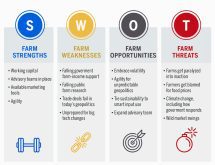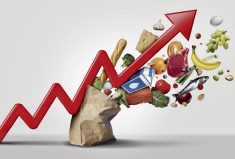Farmers almost universally accept the premise that a drop in the Canadian dollar is bullish for our agriculture because our commodities are priced off the U.S. This increases our prices domestically and also makes us more competitive both in the U.S. and in regions where commodity transactions are made in American dollars.
But is this premise valid? Are Canadian farmers truly better off with low energy prices and the low Canadian dollar that those oil prices have produced?
For example, while there is no question a lower Canadian dollar increases the competitiveness of commodities sold into the U.S. it only means we are more competitive against U.S. farmers. Yet the currencies of some our competitors, like Russia and Brazil, have fallen even more against the U.S. dollar than the loonie. On a global scale some of our competitors have become more competitive than both the U.S. and Canada.
Read Also

What to consider when setting up farm-related business ventures
Things to consider before launching a farm-adjacent side business.
Fortunately for Canadian farmers, Farm Credit Canada chief economist J.P. Gervais notes countries like Russia and Brazil are actually in recession As a result, exporters there are running into infrastructure problems as well as inflation pressures. This erodes some of their ability to export their commodities.
While a low dollar supports our exports, Canadian farmers are seeing price increases for inputs that are priced in U.S. dollars. There is significant sticker shock for anyone pricing new equipment due to the exchange rate. Even used equipment value is supported as savvy American farmers look north of the border to purchase used equipment with their stronger greenback. The bottom line is that any inputs purchased in U.S. dollars are more expensive.
Higher prices can even apply to inputs produced in Canada. Fertilizer, a major expense for Canadian farmers, is traded and priced in U.S. dollars. What’s more, the price that Canadian farmers pay for fertilizer isn’t set based on Canadian supply and demand fundamentals, or even on the cost of production in Canada. Instead, Canadian fertilizer prices are backed off international prices, either from the Black Sea market (the largest fertilizer market) or at the U.S. Gulf Coast.
Even though much of the fertilizer Canadian farmers use is produced right here in Canada, we pay an international price plus transportation costs in U.S. dollars.
This means Canadian farmers face the double whammy of not getting the full benefit of lower prices in the world fertilizer market resulting from the decline in energy costs, plus we get to pay for the fertilizer in U.S. currency.
Gervais admits that specific sectors of the industry such as feedlots and packing plants will face tighter margins as they are competing with U.S. feedlots for the purchase of cattle.
When asked what management steps farmers should be taking in light of the low commodity prices and our low dollar, Gervais had this advice: “Be aware of the trends in commodity prices.”
We need to recognize that global grain prices are falling, even though the fall has been masked by the decline of the loonie.
His second point was “risk management.” He believes the best way farmers can protect themselves as well as benefit in times like these with volatile energy and currency rates is good risk management in their farm operation.
Still, Gervais says: “overall there will be benefits to agriculture resulting from low energy costs. I do not see our currency or interest rates going up.”
Dina Ignjatovic, economist with the TD Bank, wrote the report “As Oil Prices Scrape the Bottom of the Barrel What Lies Ahead,” December 15, 2015. She predicts prices will stay below US$45 per barrel through mid-2016 due to a massive supply glut. Furthermore, we are not going to work through that glut any time soon given that world oil production was up 4.0 per cent year over year while world demand only grew at 2.4 per cent.
“Over the last few months, the world has been producing roughly 1.5 million to two million barrels per day in excess of demand,” Ignjatovic wrote, and she believes supplies will continue to grow for the next six to nine months. It is this glut of oil which has led to the low price of oil.
According to Ignjatovic, the low energy prices have an impact on the value of the loonie. Because we have an energy-based dollar, she foresees no increase in interest rates. Furthermore, the low dollar will continue to help farmers selling commodities in U.S. dollars. As well, since oil and gas products contribute significantly to the costs of inputs used on farms, the lower energy costs will support farm margins.
However, she also sees some negative pressures on Canadian agriculture. Farmers need to be aware of the “knock-on effect” low energy prices have on the global economy. The low price for oil has contributed to a negative sentiment in both financial and commodity markets around the world. “This sentiment is weighing on paper sales of commodities” warns Ignjatovic.
She also warns that many countries have seen a devaluation of their currencies against the U.S. dollar and this will have an impact on our competitiveness in commodities. While there will be good opportunities for marketing crops such as canola, other crops like wheat will be harder to sell as other countries will be even more competitive due to the difference in currencies.
She reminds growers that the world is coming out of three years of bumper crops and that world grain supplies are high. Therefore there is supply/demand pressure on commodity prices. In her TD Special Report: “Canadian Agriculture Sector: Prices Down, but Loonie Providing Some Offset,” November 6, 2015, she included a chart from Haver Analytics showing the change in agricultural commodity prices from July 2014 to October 2015 in both U.S. and Canadian dollars.
Priced in U.S. dollars, ag commodities are down across the board. However, in Canadian dollars, prices are up for corn, barley and cattle. While it is a great graphic for showing the impact of currency on prices, more importantly it shows how the rise in the Canadian dollar has offset some of the real decline of commodity prices in the world (see Chart 1 below).
When asked about biofuels, Ignjatovic feels this market may not grow as fast. However, because of the push to green energy and the mandated use of biofuels, she does not see a reduction in demand, even though there has been talk in the U.S. of reducing the mandate.
Such a reduction could have a profound effect on commodity prices given 40 per cent of the U.S. corn crop goes to ethanol production now, and biodiesel is a major use of our canola crop.
Ignjatovic’s advice to farmers is to be conscious of what is going on in currency, energy and commodity markets. She feels there will better opportunities in some crops than others. For example, she feels “canola will outperform some other crops.” However she warns farmers of the importance of agronomics and to consider good stewardship and management practices when deciding the crops to plant this year.
Ignjatovic agrees farmers need to protect themselves. “Don’t run up debt; know your costs of production and your revenues and expenses. Don’t expect to see commodity prices rising anytime soon.”
Since both Gervais and Ignjatovic said risk management was very important, I turned to Rick DeHod, farm financial specialist with the Alberta agriculture ministry and asked what management practices farmers should consider for risk management in light of the low dollar and low energy costs. He was very direct in his answer: “Farmers need to know their costs!” He went on to say this is not only the cost of production but also household costs and the amount of money they were withdrawing from the farm for living expenses.
DeHod also referred to the 2015 study “DOLLAR$ AND SENSE, Measuring the Tangible Impacts of Beneficial Business Practices on Canadian Farms,” a joint effort of the Agri-Food Management Institute and Farm Management Canada. According to the study, successful farm managers:
- Never stop learning.
- Keep finances up-to-date to help make business decisions.
- Seek the help of advisers/consultants.
- Write down a business plan, follow it, and review it annually.
- Know cost of production and what it means for profits.
- Complete a risk assessment.
- Develop a budget and financial plan.
DeHod feels Canadian farmers need to practice these seven steps every year, but they are even more critical given the current volatility in commodity prices and the low dollar.

















